Archive for the 'FILM ART (the book)' Category
Swords vs. lightsabers

Solaris.
Kristin here–
On April 12, Jason Silverman posted a brief piece on Wired: “Writers, Directors Fear ‘Sci-Fi’ Label Like an Attack from Mars.” According to Silverman, film studios, book publishers, novelists, film directors, and other involved in the creative process often try to find alternative descriptions when publicizing their work. Thus Cormac McCarthy’s novel The Road is “post-apocalytic” or “dystopian.” The executive producer of Battlestar Gallactica, Ronald D. Moore, is quoted: “It’s fleshed-out reality. It’s not in the science-fiction genre.” Never mind that it plays on the Sci-Fi Channel.
Such obfuscation is not universal. Plenty of works get labeled “science fiction.” Still, according to Silverman, the term sci-fi is dodged “especially when it applies to ‘serious’ fiction or cinema.”
There is something to this, though it needs to be qualified and expanded in a way that Silverman couldn’t do in such a short piece.
I think recent years have actually witnessed a decline in the popularity of sci-fi genre in the cinema. In discussing the impact of The Lord of the Rings in The Frodo Franchise (Chapter 9), I trace the ending of the major sci-fi franchises and the rise of their replacement: fantasy franchises. Already in late 2002, Lev Grossman wrote a perceptive article for Time, “Feeding on Fantasy” that noted the downward trend in sci-fi and the concurrent rise in the popularity of fantasy.
Fantasy films used to be considered box-office poison. In the January 2002 issue of Empire, Adam Smith published “Fantasy Island,” (which I can’t find online) listing a whole series of fantasy duds (Willow, anyone?). For some reason, Smith and some other like-minded commentators on this subject ignore the work of Tim Burton, whose Beetle Juice (1988) and Edward Scissorhands (1990) are surely classics of the genre.
Now perhaps it is science fiction that has become dubious box-office fare. Since 2000, sci-fi hits that were not part of an established franchise have been few and far between: War of the Worlds (2005), I, Robot (2004), and Planet of the Apes (2001). The first two had the advantage of starring two of the most popular actors in the world. Minority Report (2002) was considered a solid success, and again it had the advantage of Tom Cruise and Steven Spielberg’s names attached.
OK, Battlefield Earth was an unparalleled flop, but middling to disastrous sci-fi releases are easy to find (and here I’m defining sci-fi according to the genre lists on Box Office Mojo). Among the also-rans: AI: Artificial Intelligence (2001), The Adventures of Pluto Nash (2002), Solaris (2002), Simone (2002), The Time Machine (2002), Rollerball (2002), The Stepford Wives (2004), Hitchhiker’s Guide to the Galaxy (2005), and, perhaps cursed by its title, Doom (2005).
Even Joss Whedon, who had tremendous success with Buffy the Vampire Slayer and its spin-offs, hit a brick wall with his sci-fi TV series Firefly and its film continuation Serenity (2005).
Fantasy, on the other hand, has become so prominent and so successful that it is hardly necessary to list examples. X-Men, Spider-Man, Rings, Harry Potter, The Chronicles of Narnia, and Pirates of the Caribbean are hugely popular franchises. Add on animated fantasies like those made by Pixar, and fantasy practically rules the box office. A surprising number of current big-budget projects are fantasies (among the most prominent, His Dark Materials: The Golden Compass).
By the way, here I include both the X-Men and Spider-Man series as fantasy rather than science fiction, which is debatable. Each offers some sort of physical explanation for the super-powers of their characters: various genetic mutations of uncertain cause, a spider bite during a school lab fieldtrip. These are not scientific explanations, though, at least not of the semi-plausible sort that sci-fi films usually delight in providing.
Genres move in cycles, and sci-fi films will probably return to prominence. For the moment, though, cable television seems to have become the medium where sci-fi thrives. Battlestar Galactica is one example. MGM is currently using the success of its “stalwart” Stargate series to move into foreign television markets. (For a Variety story, click here.) Stargate already has one spinoff, another is in the works, and two movies are planned. (Maybe MGM should reconsider that last idea.) There’s always the possibility of another Star Trek TV series.
Sci-fi films are far from moribund, however, and not everyone shuns calling them by that name. Most obviously, James Cameron’s ambitious project Avatar, currently announced for May 22, 2009, is underway. (The announcement in Variety calls it a sci-fi film.) A film often referred to as Star Trek XI has a release date of December 25, 2008.
Silverman’s article expresses puzzlement that in an era when science is such a prominent part of our lives, the genre of science fiction should loose favor. My own guess would be that it is precisely because technology is advancing at such a dizzying rate that stories about a real or alternative future may seem a bit tame.
When we casually refer to robots as “bots,” have mechanical dogs in our homes, and watch rovers photographing Mars, are films about robots quite as interesting as they used to be? Unless they star Will Smith, of course. When companies are actually planning to offer space tourism to paying customers within some of our lifetimes, are fictional rocket ships as intriguing? And perhaps we have simply by now seen stories based on these subjects a bit too often. Perhaps to find renewed respectability, the genre needs to move beyond its most familiar conventions.
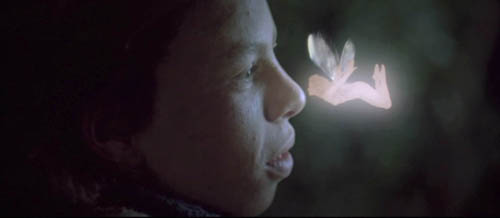
Willow.
The Celestial Multiplex
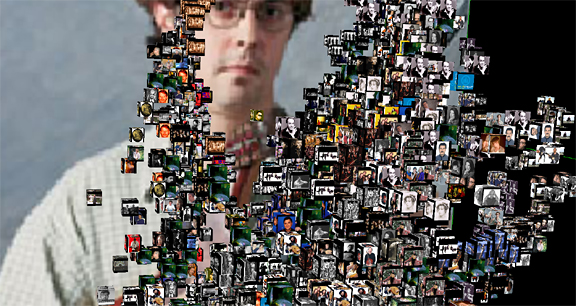
Kristin here—
The Internet is mind-bogglingly huge, and a lot of people seem to think that most of the texts and images and sound-recordings ever created are now available on it—or will be soon. In relation to music downloading, the idea got termed “The Celestial Jukebox,” and a lot of people believe in it. University libraries are noticeably emptier than they were in my graduate-school days, since students assume they can find all the research materials they need by Googling comfortably in their own rooms.
A lot depends what you’re working on. For The Frodo Franchise, studying the ongoing Lord of the Rings phenomenon would have been impossible without the Internet. A big portion of its endnotes are citations to URLs. On the other hand, my previous book, Herr Lubitsch Goes to Hollywood, a monograph on the stylistic and technical aspects of Ernst Lubitsch’s silent features, has not a single Internet reference. Lubitsch can only be investigated in archives and libraries, where one finds the films and the old books and periodicals vital to such a project.
Vast though it is, the Internet is tiny in comparison with the real world. Only a minuscule fraction of all the books, paintings, music, photographs, etc. is online. Belief in a Celestial Jukebox usually works only because people tend to think about the types of texts and images and sounds that they know about and want access to. Yes, more is being put into digital form at a great rate, but more new stuff is being made and old stuff being discovered. There will never come a time when everything is available.
Even so, every now and then someone proclaims that in the not too distant future all the movies ever made will be downloadable for a small fee, a sort of Celestial Multiplex. A. O. Scott declared this in “The Shape of Cinema, Transformed at the Click of a Mouse” (New York Times, March 18): “It is now possible to imagine—to expect—that before too long the entire surviving history of movies will be open for browsing and sampling at the click of a mouse for a few PayPal dollars.”
Not only that, but Scott goes on, “This aspect of the online viewing experience is not, in itself, especially revolutionary.” He’s more interested in the idea that online distribution will allow filmmakers to sell their creations directly to viewers. That would be significant, no doubt, but as a film historian, I’m still gaping at that line about “the entire surviving history of movies.” Such availability would not only be “revolutionary,” it would be downright miraculous. It’s impossible. It just isn’t going to happen.
(The image above was generated to publicize the “Search inside the Music” program that is an important part of the Celestial Jukebox. Imagine movie screens with actors’ faces in those little boxes, and you’ve got the Celestial Multiplex.)
I will give Scott credit for specifying “surviving” films. Other pundits tend to say “all films,” ignoring the sad fact that great swathes of our cinematic heritage, especially in hot, humid climates like that of India, have deteriorated and are irretrievably lost.
Dave Kehr has already briefly pointed out some of the problems with Scott’s claims, mainly the overwhelming financial support that would be needed: “Tony Scott’s optimism struck me as, well, a little optimistic.” On the line about “the entire surviving history of movies,” Kehr suggests, “That’s reckoning without the cost of preparing a film for digital distribution — the same mistake made by the author of the recent vogue book ‘The Long Tail’ — which, depending on how much restoration is necessary, can run up to $50,000 a title. None of the studios is likely to pay that much money to put anything other than the most popular titles in their libraries on line.” As Kehr says, the numbers of films awaiting restoration and scanning isn’t in the hundreds, as Scott casually says. No, it’s in the tens of thousands even if we just count features. It’s more like hundreds of thousands or more likely millions if we count all the surviving shorts, instructional films, ads, porn, everything made in every country of the world. To see how elaborate the preservation of even one short medical teaching film can be, go here.
Putting aside the need for restoration, newer films present a daunting prospect. To help put the situation in perspective, let’s glance over the total number of feature films produced worldwide during some representative years from recent decades (culled from Screen Digest‘s “World Film Production/Distribution” reports, which it publishes each June): 1970, 3,512; 1980, 3710; 1990, 4,645; 2000, 3,782; and 2005, 4,603. For me the numbers conjure up the last shot of Raiders of the Lost Ark, only with just stack upon stack, row upon row of film cans.
Scott isn’t the first commentator to prophesy that all films will eventually be on the Internet. It’s an idea that crops up now and then, and it would be useful to look more closely at why it’s a wild exaggeration. It’s not just the money or the huge volume of film involved, though either of those factors would be prohibitive in itself. There are all sorts of other reasons why the advent of practical digital downloading of films will never come close to providing us with the entire history of cinema.
Coincidentally, two experts on this subject, Michael Pogorzelski, Director of the Film Archive of the Academy of Motion Picture Arts and Sciences, and Schawn Belston, Vice President, Film Preservation and Asset Management for Twentieth Century Fox, visited Madison this past week. Mike got his MA here in the Dept. of Communication Arts and now returns about once a year to show off the latest restored print that he has worked on. Schawn isn’t an alum, but he has also visited often enough that most students probably think he is. The two brought us the superb new print of Leave Her to Heaven that Fox and the Academy have recently collaborated on.
I figured it would be very enlightening to sit down with these two and talk about why the Internet is never going to allow us to watch just anything our hearts desire. They kindly agreed, and with my trusty recorder in tow we went for burgers—and fried cheese curds, a commodity not available in Los Angeles—at the Plaza Tavern. I’m grateful for the fascinating insights they provided into some of the less obvious obstacles to putting films on the Internet en masse.
No Coordinating Body
Before we launch in, though, one point needs to be made: there is no single leader or group or entity out there organizing some giant program to systematically put all surviving movies on the Internet. There isn’t a set of guidelines or principles. There’s no list of all surviving films. How would we even know if the goal of putting them all up had been achieved? When the last archivist to leave turned out the light, locked the door, and went looking for a new line of work?
Most of the physical prints that would be the basis for such transfers are sitting in the libraries of the studios that own them or in the collections of public and private archives (including many individuals). The studios would make films available online for profit. The archives might be non-profit organizations, but they still would need to fund their online projects in some fashion, either by government support, from private grants, or by charging a fee for downloads. Most archives are more concerned about getting the money to conserve or restore aging, unique prints than about making them widely available. Preservation is an urgent matter, and making the resulting copies universally available for public entertainment or education is decidedly a secondary consideration.
Mike works for a non-profit archive, Schawn for a studio, so together they provide a good overview of some key problems facing the creation of an ideal, comprehensive collection of movies for download.
Money
People who claim that all surviving films could simply be put on the Internet don’t go into the technology and expenses of how that could be done.
Of course, Schawn says, studios want to “digitize the library.” That phrase is highly imprecise, however. He specifies, “For the purposes of this idea of media being online, available, downloadable, streamable, whatever, that’s something that we’re dealing with now using existing video masters. So there isn’t an extra cost to quote, unquote digitize. But there is a cost to make the compression master, what we’re calling at Fox a ‘mezzanine file,’ which is basically a 50 megabit file. That’s the highest-quality ‘low’ quality version of the content from which you can derive all of the different flavors of compression for the various websites that have downloadable media.
“There’s a huge problem with this, in that Amazon, iTunes, and Google all have a slightly different technical specification of how they need the files delivered to them. If you don’t have this kind of mezzanine file, you have to make a different compressed version for each one of these, which costs something, certainly. It’s not incredibly expensive, but it’s not free.
“So why? What’s the motivation to us to compress at Fox the entire library? I don’t know. Are we going to sell enough copies of Lucky Nick Cain [a 1951 George Raft film] compressed on iTunes to cover the costs of making the compression? I don’t think so.”
Compatibility and the Onrush of Technology
Schawn’s mention of the variety of files needed by the big download services raises the problem of compatibility. It’s not just a matter of supplying the files and then forgetting about the whole thing, assuming that the film is available to anybody forever. What about new standards and formats?
Shawn: “Just as with consumer video, the standard changes, so what used to be acceptable yesterday isn’t acceptable now in terms of technical quality.” As time passes, plug-ins make access faster and cheaper, and eventually the original files don’t look good enough. He points out that currently iTunes can’t download HD. If it becomes possible later, “If you want to get 24 in HD, what Fox will have to do is go and re-deliver all the files in HD.” And presumably re-deliver again when the next big format revolution occurs.
Mike explains further, “Using the mezzanine file, you would just have to continue to reformat it to whatever the players demand. The lowest of the low quality will keep going up as people have broadband and can handle larger chunks of data faster.”
What about the film you’ve already downloaded? You acquire films using plug-ins, which change. Think how often you’re told that an update is now available. If you go ahead and keep updating, the changes accumulate. Eventually you may not be able to play the download you paid for. Quicktime will have moved way beyond what the technology was when you made your purchase.
Schawn and Mike both point out that at this stage in the history of downloading, the level of quality is still pretty bad in comparison with prints of films in theaters or on DVDs. It would be nice to think that the virtual film archive could provide sounds and images worthy of the movies themselves, but that will take a long, long time–not the “before too long” that Scott envisions.
Copyright
I raised another matter: “But what about copyright? Every time I hear something about restoration or bringing something out on DVD, it’s, ‘Well, there are rights problems.’ And some of those rights problems don’t get resolved. I assume that quite a few films that they blithely believe can be slapped up for downloading can’t be slapped up.”
Schawn: “Sure, and there are often not any kinds of provisions in the contract about Internet distribution—obviously! So you’re right, how do you deal with that?”
He pointed to Viva Zapata as a film that Fox has restored but can’t make available due to rights issues. The potential sales are not thought to warrant paying to resolve those issues. “I’m sure there are lots of titles in everybody’s libraries that you can’t just pop up on the Internet and start selling.”
The copyright barrier is worse for archives, which seldom own the exhibition or distribution rights to the films they protect. Usually—though not invariably–the studios do not object to archives owning and preserving prints. Making money through showing them or selling copies would be quite another matter.
Mike described the online presence of archival prints. “On a much smaller scale, this is being attempted in the archive world already, like on Rick Prelinger’s site [Prelinger Archives] or on the Library of Congress’s site, where they’ve put up dozens of moving-image files. True, it’s not independent cinema and it’s mostly commercials and the paper prints that have recently been restored. On Prelinger’s site it’s all the industrial films that he’s collected over the years. That has seen a good amount of traffic, but it hasn’t created new audiences for these films, I would argue. At least, not on a huge scale.”
Prelinger’s site contains only public-domain items, including the ever-popular Duck and Cover, allowing him to avoid the problem of copyright. Similarly, the Library of Congress gives access primarily to films in the pre-1915 era.
Suppose an archive and a film studio both have good-quality prints of a minor American film made in the 1940s. The archive does not have the legal right to put it online, and if the studio decides that it does not have the financial incentive to do so, that film will not be made available for downloading. A private collector might possibly create a file and make it available, but he or she would risk being threatened by the copyright-holder.
Piracy
We briefly discussed the methods used to prevent pirated copies being made from downloaded films. Like DVDs, downloads can be pirated, with people sending copies to their friends or even offering downloads for a fee in competition with the copyright holder. Copy-protection codes might make it necessary for a purchaser to keep a downloaded copy only on a hard-drive without being able to burn it onto a DVD. Another type of code could erase the file once the film had been viewed once or twice. That’s not exactly conducive to the ideal archive of world cinema, where we would hope to be able to study a film in detail if we so choose.
One might think that piracy protection mainly applies to studios, with their need to make money. Mike points out, though, that the need for such protection “even applies to the archival model, too. For films that you mention that have gone out of copyright, there’s still the same costs associated with putting a silent film that no one owns–digitizing it, creating the compressed master that goes on the Web—and they aren’t the kinds of subjects that people are going to get rich on at all, so there isn’t a lot of piracy. You don’t hear many archivists complaining, ‘Hey, you took my 1911 Lubin film, damn you! You can’t put that on your Website. That belongs on the archive’s Website.’ But that scenario becomes more of a likelihood for more popular titles. The obscure 1911 Lubin film is on one extreme, but Birth of a Nation, a well-known silent film a lot more people would like to see, is on the other. Let’s say the highest-quality copy is on the Museum of Modern Art’s Website and can be easily lifted and posted on your own site. And even if you just say, ‘Oh, I’ll charge 99 cents or I’ll charge 50 cents to stream it,’ it’s still going to be someone taking over something that the archive put all of the high-end effort and money into doing. Frankly, I think unless it’s an archive with a national mandate and a little bit higher budget to digitize and to put the contents of their archives online, there’s not going to be any motivation to make that high-end investment up front.”
Thus an archive may simply not bother to put a film on the internet because it can’t guarantee recouping the costs that would be generated.
Language and Cultural Barriers
Scott’s notion of easy access to all of surviving world cinema implicitly depends on an idea that all these films are either English-language or already subtitled or dubbed for English-speaking users.
That’s not true for a start, so there would remain a great deal of work to translate films that have never been released in English-language markets. That’s another huge, expensive task.
Then there’s the opposite side of that coin. For truly complete access, everyone in the world, whatever language they speak, would be able to download and appreciate every film. Of course, there are billions of people without computers or Internet access, and it looks unlikely that being able to go online will become universal anytime soon. (For figures on numbers of people with internet access, check here; percentages can be calculated by clicking on each country and finding the total population. In Tajikistan, for example, .07% of the population was online in 2005. One has to assume that a lot of connections in some of those countries are dial-up, so downloading films would be virtually impossible. [June 21, 2010: In 2008, Tajikistan’s online population has grown to .08%.])
So let’s just say that for the foreseeable future downloadable films would “only” need to be subtitled in the languages of countries or regions where significant numbers of people subscribe to PayPal.
In our conversation, Schawn pointed out that digital compression files mean that there can be huge numbers of versions, with different soundtracks dubbed in or different subtitles added. Technically it’s possible to do all that translation. Still, “it’s very complicated. So for worldwide distribution of anything, like you’re talking about your silent film. If you’re in Pakistan, do you get the American version of the movie or do you get the version of the movie with the intertitles appropriate to wherever it is that you’re showing it? If so, that quickly compounds the amount of stuff that’s digitized.”
I responded, “Yeah, or a 1930s Japanese film put on the Internet for downloading, subtitled in every language where there are people that can pay for it. The more you think about it, the more absurd it becomes.”
Scott must be implying as well that there is some single “original” version of a film and that that version would be the one available in this ideal collection in cyberspace. Yet any archivist or film historian knows that multiple versions of a given film are typically made, depending partly on the censorship laws of the different countries where it is originally shown. In making downloadable files available, does a studio or archive use only the original version of a film made for its country of origin and thus risk having it include material offensive to viewers in some places where it might be downloaded? Or does a whole slew of different versions, one acceptable in, say, Iran, another inoffensive to the Danes, and still another compatible with Senegalese social mores, get put online? How could one even gather all such versions and digitize them? National film archives tend to have government mandates to concentrate primarily on preserving their own countries’ films. Not every version of every film gets saved.
The Bottom Line
For all the reasons noted here and others as well, film availability for download will follow pretty much the same economic principles that have governed film sales in other media. Mike’s opinion is, “Whether they’re from an archive or a studio, I think things’ll start going online in the same pace that they came onto DVD, in an eight to ten-year cycle. And there still will be large gaps.”
Schawn interjects, “Just as there are on DVD.”
Mike concludes, “There’s stuff that will never go online. Yeah, just as on DVD.”
*
A truly celestial screening: a restored 35mm print of Bertolucci’s 1900 projected free, under the stars in the Piazza Maggiore, Bologna, summer of 2006
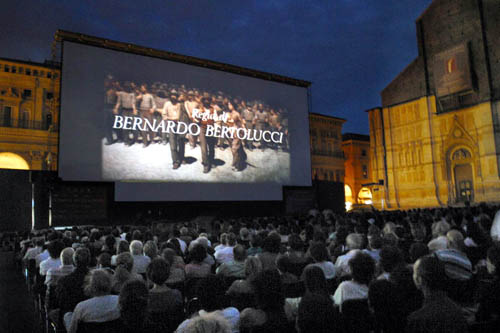
A many-splendored thing 4: Triangulating

DB, still in Hong Kong:
Three directors of renown collaborate on a single film. Each is responsible for one part. But unlike your ‘portmanteau film,’ which tells separate stories (e.g., RoGoPaG or Paris je t’aime), in this project the same plot and characters are followed throughout. To make things interesting, the director of part one doesn’t tell the others what he’s planning; he simply presents a finished third. The second director has to take that further, and the man at the end has to wrap things up.
Hong Kong director Johnnie To came up with the idea for Triangle, and it’s nearing completion. Tsui Hark has finished the first section, Ringo Lam the second. Now To is shooting the conclusion, and he kindly invited Shelly Kraicer (Chinese movie expert), Todd Brown (of Twitchfilm.net), Antoine Thirion (of Cahiers du cinéma), and your obedient servant to a late-night shoot on Thursday. Milkyway mainstay Shan Ding was our guide.
I don’t have to tell you it was fun.
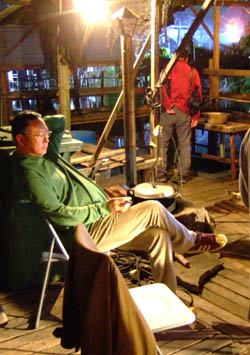
The setting is a rundown cafe perched on a swampy pond in the New Territories. The location is near the forest where the armored-car shootout takes place in Exiled. We saw To shoot a scene with Lam Suet, Louis Koo, and other actors meeting in the café. In this portion, Lam is sprawled on the floor.
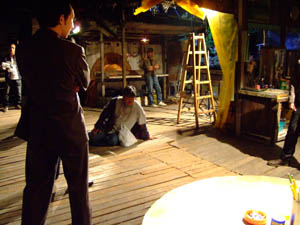
The scene climaxes with one actor dangling from a hole in the roof. You can see Mr. To in the lower right foreground watching the shot on his video assist, a monitor that shows what the camera sees. Maybe you can glimpse the shadowy assistant on the rooftop helping the actor hold on.
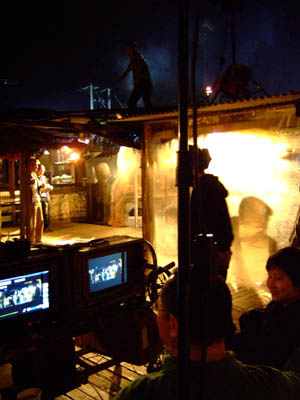
Meanwhile, the camera is shooting off on the right. It was a good opportunity to watch how To uses camera movement (constant in his films). Here you can see the camera dolly and the rail tracks it coasts along.
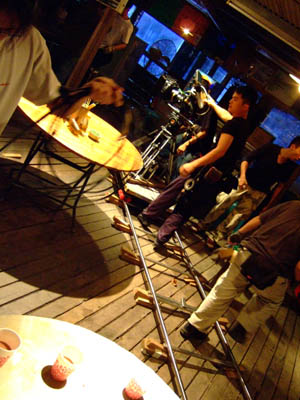
Louis Koo was also there, but not too visible. Simon Yam showed up for another scene, this one in the forest. Simon exudes charm and is warm and unpretentious. I first met him in 1995 at the Hong Kong Film Awards banquet, and he looks as handsome and mischievous as ever.

Kelly Lin arrived soon afterward. Another charmer, she told me she grew up in Santa Barbara and went to UC-Irvine. She’s been in a lot of recent HK movies.

Later, shooting in the forest, the Milkyway team worked efficiently. We guests were parked on a little pier to watch from a distance.
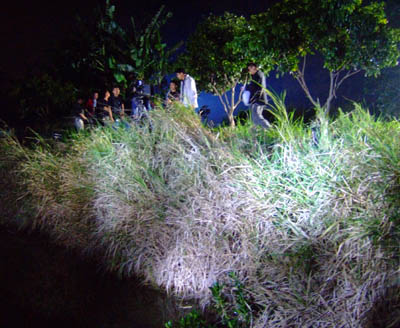
A crew member rustled a big sheet of plastic to create the impression of reflections from the water.
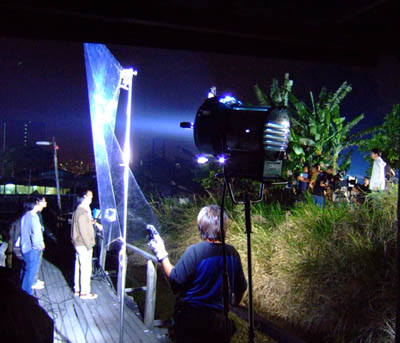
I’ve visited other Milkyway shoots, and each time I’ve been impressed by the sheer speed with which the work gets done. Everybody knows his/her job, and the staff changes camera and lighting setups very quickly. It also helps that HK films are almost always shot with no sound recording; everything is postdubbed. That yields the visual freedom, as well as the speed of production, of silent-era moviemaking.
In another echo of old production methods, To’s films sometimes use rooftop sets. Last year the set for the hotel in Exiled was erected on the top of the Milkyway building. Its Demy-like pastels looked very artificial in daylight.

But check out the results on film, shot at night.
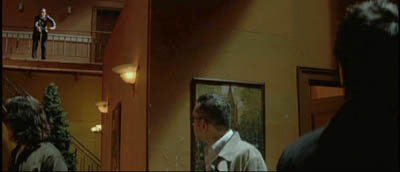
To’s art is furthered by his craftsmanship in shot composition. Composing in anamorphic (2.35:1), nearly always putting the camera on a tripod or dolly, he gets precise results with few lighting units. When I complained that all the new films I saw at Filmart were shot shakycam, Shan Ding reported a neat saying that HK DPs have. The handheld camera covers 3 mistakes: Bad acting, bad set design, and bad directing.
Unlike Hollywood filmmakers, who fiddle with the film by pushing and pulling and bleach bypassing and digital fixing in postproduction, Mr To just lets the film do its rich photochemical work. Expose it correctly, anchor the camera, and 35mm film stock can look gorgeous. His films show that we already have a high-definition moving-image medium, using not pixels but molecules. Motto: Let the emulsion be your friend.

Shan also told me that the anamorphic format used by Milkyway is Technovision, an Italian system from the 1970s. These lenses yield lovely images with good depth of field, and To likes to fill up the wide frame with complicated blocking. Here’s an example from Exiled.
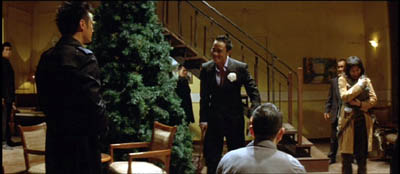
According to Rick Mitchell, Vittorio Storaro used Technovision lenses on Apocalypse Now and other pictures. It’s another way in which To is maintaining a heritage of quality—while also being economical. Milkyway owns the lenses, so no need to rent from local supply houses.
Mr To, Shan Ding, and the rest of the crew were very kind to us, even providing snacks and suggesting a group picture. Who could resist an offer like that?
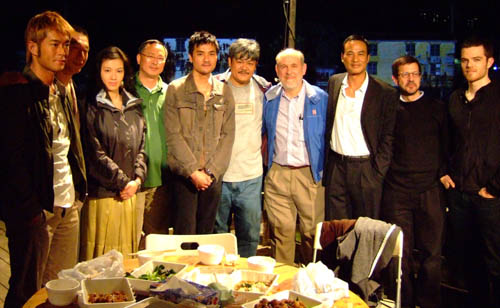
Later in my stay, I hope to report on another upcoming Milkyway film, the Simon/ Kelly pickpocket movie called The Sparrow.
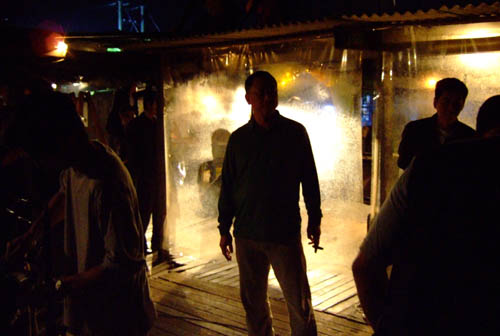
PS 24 March: I was told that Johnnie To came up with the idea for Triangle, but Vicki Rothrock reports for Variety that it was Tsui’s concept originally. Thanks to D. W. Hudson of GreenCine Daily for the link.
PPS 27 March: For Todd’s coverage of our set visit , go to Twitchfilm here.
PPPS 14 May: Per Variety, Triangle is a late addition to Cannes.
PPPPS 4 December 2010: Correction: The original entry claimed, inaccurately, that Mr. To used Techniscope, a two-perforation non-anamorphic format. The process being used is in fact Technovision, an anamorphic format. My apologies for the error.
Trims and outtakes
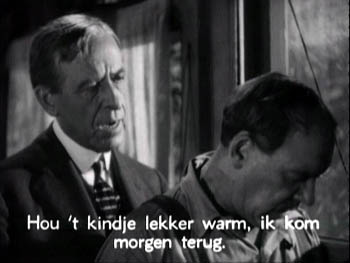
Some jottings from DB:
Continuity Boy meets Badgers
 Tim Smith, who studies how we perceive film, recently visited our department at the University of Wisconsin–Madison. His talk was splendid.
Tim Smith, who studies how we perceive film, recently visited our department at the University of Wisconsin–Madison. His talk was splendid.
Tim studies the ways we scan shots and shift our attention across cuts. His talk was illustrated with film sequences showing little yellow dots swarming around the frame; these indicate the points in the image where his subjects’ glances landed. Tim shows pretty conclusively that there’s a consensus about where viewers look during a shot (faces, movement, the center of the frame) and that classical continuity cuts can push our attention to and fro with remarkable facility. One of the most surprising findings was that viewers are often starting to shift their attention to a new frame area just before the cut comes. Why? Tim has some intriguing suggestions.
Tim also showed some remarkable effects of what I’ve called “intensified continuity,” the fast-cut close-ups that characterize so much current cinema. Because these passages leave no time for visual exploration, viewers seem to revert to a cursory test for the shot’s basic point, usually at the center of the frame. Tim’s examples from Requiem for a Dream were fascinating, showing how real viewers are playing catchup in very fast-cut sequences.



This is rich and promising research, showing once more that Leonardo da Vinci, Eisenstein, and a few others were right to think that many creative choices in the arts can be studied with the tools of science. It also shows that filmmakers, like other artists, are seat-of-the-pants psychologists, achieving complex effects through decisions that “feel right” and that they have no need to explain theoretically. That’s our job.
For Tim’s narrative of his visit, and a lot more about his research program, go here. For something not quite completely different, about eye-tracking, print ads, and crotches, go here.
Six more from RKO
The enterprising folks at Turner Classic Movies have discovered six RKO films that have been missing for many years. It’s a harvest of 1930s titles, promising some intriguing situations (e. g., Ginger Rogers as a telemarketer) and carrying the names of directors like William Wellman, John Cromwell, and Garson Kanin.
A Man to Remember (1938; at the top of this page), Kanin’s first film, is the only one of the batch I’ve seen so far. One of the New York Times‘ ten best films of 1938, it went virtually unseen until a print surfaced at the Netherlands Filmmuseum in 2000. A Man to Remember is a portrait of a small-town doctor who tends to the poor and lets others, chiefly a cadre of corrupt businessmen, take credit for his good works.
It could all be mawkish, but Edward Ellis plays the doctor as a testy guy who levels with his patients and wins the town’s respect through quiet cussedness. The performance echoes Ellis’ crabby but likable inventor in The Thin Man (1934). Dalton Trumbo’s script has an intriguing flashback structure, less bold than in The Power and the Glory (1933) but still ambitious for a B project.
The six RKO discoveries are screening on April 4th as an ensemble, then they’re scattered through the rest of the month. All should be worth checking out. Once more TCM proves itself the film-lover’s channel of first choice.
Bambi or kitty?
Two recent books support the claim that New Hollywood, or New New Hollywood, is at bottom in debt to old Hollywood. (The full case is presented in The Way Hollywood Tells It and Kristin’s Storytelling in the New Hollywood.)
 David Mamet’s Bambi vs. Godzilla: On the Nature, Purpose, and Practice of the Movie Business (Pantheon) is as pungent and eccentric as you’d expect, but also deeply traditional in its storytelling advice. A movie’s characters must have goals, and over the course of three acts they achieve them, or definitively don’t. The Lady Eve is Mamet’s model of this construction. Furthermore, three questions structure every scene: Who wants what from whom? What happens if they don’t get it? Why now? In wide-ranging essays, Mamet pays tribute to the craftsmanship of below-the-line talent and celebrates movies as various as The Diary of Anne Frank and I’ll Sleep When I’m Dead (whose protagonist is remarkable for “his personification of enigma”).
David Mamet’s Bambi vs. Godzilla: On the Nature, Purpose, and Practice of the Movie Business (Pantheon) is as pungent and eccentric as you’d expect, but also deeply traditional in its storytelling advice. A movie’s characters must have goals, and over the course of three acts they achieve them, or definitively don’t. The Lady Eve is Mamet’s model of this construction. Furthermore, three questions structure every scene: Who wants what from whom? What happens if they don’t get it? Why now? In wide-ranging essays, Mamet pays tribute to the craftsmanship of below-the-line talent and celebrates movies as various as The Diary of Anne Frank and I’ll Sleep When I’m Dead (whose protagonist is remarkable for “his personification of enigma”).
Mamet adds a fair amount on editing, supplementing the remarks in his Pudovkin-flavored On Directing Film. For instance: “At the end of the take, in a close-up or one-shot, have the speaker look left, right, up, and down. Why? Because you might just find you can get out of the scene if you can have the speaker throw the focus. To what? To an actor or insert to be shot later, or to be found in (stolen from) another scene. It’s free. Shoot it, ’cause you just might need it.”
Mamet bemoans the script reader, whose motto must be Conform or Die. By contrast, Blake Snyder makes conformity seem fun and–well, if not easy, at least attainable. His Save the Cat! The Last Book on Screenwriting You’ll Ever Need (Michael Wiese Productions) bulges with formulas, recipes, and gimmicks.
 Like Kristin and me, Snyder treats the Second Act as really two sections, broken by a midpoint. But for him three acts are just the beginning. He demands that there be an Opening Image (on script p. 1), Theme Stated (p. 5), Catalyst (p. 12) and on and on until we get the Finale (pp. 85-110) and the Final Image (p. 110). This is the most strictly laid-out cadence I’ve seen; it would be fun to see if actual scripts adhere to it. In addition, you get catchy tips like Save the Cat! (show the protagonist doing something likable early on) and the Pope in the Pool (burying exposition). Snyder includes a list of the most common screenplay errors. An enjoyable read with some hints about construction I hadn’t encountered before.
Like Kristin and me, Snyder treats the Second Act as really two sections, broken by a midpoint. But for him three acts are just the beginning. He demands that there be an Opening Image (on script p. 1), Theme Stated (p. 5), Catalyst (p. 12) and on and on until we get the Finale (pp. 85-110) and the Final Image (p. 110). This is the most strictly laid-out cadence I’ve seen; it would be fun to see if actual scripts adhere to it. In addition, you get catchy tips like Save the Cat! (show the protagonist doing something likable early on) and the Pope in the Pool (burying exposition). Snyder includes a list of the most common screenplay errors. An enjoyable read with some hints about construction I hadn’t encountered before.
Speaking of screenplays….
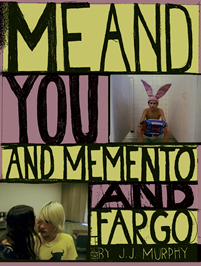

J. J. Murphy is an old friend (we went to grad school with him in 1971) and colleague (he teaches in our department). Renowned as an experimental filmmaker, he has turned his attention to American indie cinema. His new book Me and You and Memento and Fargo: How Independent Screenplays Work offers an in-depth analysis of several recent films. J. J. shows how they obey mainstream conventions of construction while still innovating in other ways. I especially like his discussions of Hartley’s Trust, Korine’s Gummo, and Lynch’s Mulholland Dr. I think it’s a book that everyone interested in current American cinema would find stimulating.
You can find out more about it, and read an excerpt, here. Congratulations, J. J.!













